Visual storytelling and moving beyond ‘multimedia’: Part 2
 In Part 1 of Visual storytelling and moving beyond ‘multimedia’ freelance trainer Guy Degen explored some of the problems with the term “multimedia”. The post also featured the World Press Photo Academy-FotoFederatie study into multimedia produced by Dr David Campbell. In Part 2, we present an in-depth interview Guy conducted with David Campbell about his research and trends in visual storytelling.
In Part 1 of Visual storytelling and moving beyond ‘multimedia’ freelance trainer Guy Degen explored some of the problems with the term “multimedia”. The post also featured the World Press Photo Academy-FotoFederatie study into multimedia produced by Dr David Campbell. In Part 2, we present an in-depth interview Guy conducted with David Campbell about his research and trends in visual storytelling.
The full study PDF can be downloaded here.
Why do we struggle with the term “multimedia”? And why is “visual storytelling” more appropriate?
All terms are flawed and language has multiple interpretations, but one of the things that we set out to do was not to define anything. We’re not interested in defining multimedia as X or as Y. It’s too limiting. There’s too much creative stuff going on and it’s got to be broad, it’s got to be open, it’s got to be prepared to learn from many things. So visual storytelling is the attempt to say that this is probably the most open concept that we have for this, at the moment. Because it’s not defined by a platform, it’s not defined by tools, it’s defined by purpose and there are different purposes from spot news to background to information and magazine style features, etc. But whatever your purpose, it can be understood in that framework.
One of the things about the study is to actually say that all media is multimedia. If you look at media organisations now, it doesn’t make sense to talk about organisations as either just newspapers or broadcasters, because very few large national or global organisations that we would’ve formally called newspapers are simply not operating on a print platform any more. They’re in a web-space, they’re in a digital space, as well as on the print platform. And therefore all of their media is multimedia. The question is: which platform gets which audiences better, and which tools on which platforms tell parts of stories better?
From what we’ve learned about how the New York Times produced its highly acclaimed Snow Fall feature, there were lot of people working on it over several months – rather like TV, a very labor intensive production. Is good visual storytelling going to be produced only by the large media organisations or by organisations that can afford to buy in from independent producers?
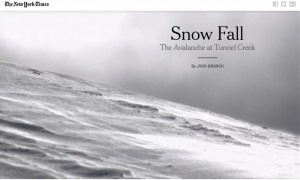 Just on that last point first, we found in the study that news organisations don’t buy in from independent production companies. They produce in house, 90% of the stuff produced in-house. The best we found was 70% in house, 30% from outside. So they are very much going for in-house teams, salaried teams to produce multimedia. That leaves independent producers in a difficult situation in relationship to them – there’s not much licensing of external stuff going on for a variety of reasons.
Just on that last point first, we found in the study that news organisations don’t buy in from independent production companies. They produce in house, 90% of the stuff produced in-house. The best we found was 70% in house, 30% from outside. So they are very much going for in-house teams, salaried teams to produce multimedia. That leaves independent producers in a difficult situation in relationship to them – there’s not much licensing of external stuff going on for a variety of reasons.
Snow Fall is a fantastic thing for us to pick our way through. I think the New York Times throws resources at things and it’s great that they do that, and it produces experimental material and so on. But it’s not necessary to do it at that scale to be effective. There is someone in fact who has produced a template that allows you to do a “Snow Fall” type of thing as a WordPress plugin that you as an individual can work with. Okay, it’s not going to be quite as flash as the New York Times but it’s going to get you two thirds or three quarters of the way there. It’s called Scrollkit.
And I think there’s a huge range of tools out there that allow individuals and smaller groups to do that. I don’t think you need to throw the New York Times scale of resources at it. I mean the audience numbers for Snow Fall are a bit misleading, because it was promoted on social media as a great format, as well as the great story. So a lot of people looked at it for how it was put together as much as what the story was saying. So, we don’t know if left to its own devices what would the story have attracted. Again, either on the business side or on the creative side, we’re not going to have single models that will rule. It’s not the case that every type of story will have to follow a “Snow Fall” type format. It might work for large magazine style features where you have time and rich resources to work with.
And, on one level Snow Fall in itself is not radical. What it does is two things. One, it gives you a scrolling experience, everything simply flows, and that represents how we’re accessing information in terms of the stream rather than the idea of the page, or a digital site, where you have to click from one to two to three to four to five. Because the studies show that every time you ask someone to click you loose people. And so when you have that scrolling experience, and that stream experience, you can keep your audience with you. That’s the first thing, and that’s actually the logic that is behind a number of redesigns. Reuters, NPR and the New York Times itself in the autumn is going to launch a whole new look and digital space that’s going to be based on that idea of the limitless page of the stream. Now, for people like us who write on blogs, there’s nothing novel. That’s the blog page. But this is not normal for an organisation that has had a content management system with a print mentality that has organised everything as pages. And this is a very different sort of approach. So, you get a more white open space, minimalist look with the text.
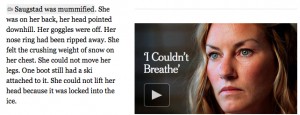 The second thing it does is use non-text elements in the appropriate place in the story when it has got the resources. So you don’t have a text page and then the sidebar with “see video” “see audio” or whatever. You have the scrolling streaming experience and when it’s appropriate to show you the audio of the 911 call, you do it in the middle of the page, then you keep reading the text. And when it is appropriate to show you the video of one of the people being interviewed, you do it in the middle of the page. And again, nothing new for people who work on blogs embedding video into the pages of your stories, but very new for a traditional media organisation who have had content management systems where they have not been able, for example: embed video on their homepage – even a major newspaper. That’s because you built a content management system based on a print structure and then migrated it to the web.
The second thing it does is use non-text elements in the appropriate place in the story when it has got the resources. So you don’t have a text page and then the sidebar with “see video” “see audio” or whatever. You have the scrolling streaming experience and when it’s appropriate to show you the audio of the 911 call, you do it in the middle of the page, then you keep reading the text. And when it is appropriate to show you the video of one of the people being interviewed, you do it in the middle of the page. And again, nothing new for people who work on blogs embedding video into the pages of your stories, but very new for a traditional media organisation who have had content management systems where they have not been able, for example: embed video on their homepage – even a major newspaper. That’s because you built a content management system based on a print structure and then migrated it to the web.
What Snow Fall indicates, is that in 2013, major media organisations are catching up to what the web does and are starting to present their information in ways that are much more friendly to digital space, and therefore more accessible from the huge range of devices you can get online with. Some media organisations are finding that there could be some 2,500 different mobile devices trying to access their sites – all with slightly different capabilities. So, this is where responsive design comes in to make that possible. That’s a major thing to think about and Snow Fall is an example of that. So it is a good example of those trends, but it’s not as some people have mistakenly read it as the model that every story will have to follow.
What about off the shelf platforms such as StoryPlanet for visual storytelling, is that a way forward?
Potentially yes. In the report there are at least eight or nine platforms or tools that are kind of like Storyplanet – there’s one called Klynt, and one called 3Wdoc. And this is what’s happening, people are putting together tools that mean you don’t have to be a coder yourself, but you will have flexible ways of presenting your material in a digital space. The point is, this works for some stories, it’s not for all stories. Your story has to have depth, it has to have branches in terms of its own content, and you have to have the resources to do that. Storyplanet works on the basis that you have a story spine. If you have that material, you can go out and build a more complex story.
The other thing about those sorts of approaches is that you’re asking a lot from your audience. You are asking the audience to commit a lot of time. And I think it’s very important to understand that audiences are very happy to commit a lot of time when they are engaged. This idea that we live in superficial way, and there’s distraction and that no one is reading any more is I think demonstrably false. And empirically wrong. But if you put every story into a Snowfall or Storyplanet format, you would be demanding that everyone spends 15, 20, 30 minutes with it. Now, we did not do that with print. Sometimes we went into the magazine section and spent time, and sometimes we skimmed the news quickly at the breakfast table – just like how we now skim Twitter quickly for a link or something like that. So I don’t think that behaviour has fundamentally changed, nor is the Internet age making us more shallower or more distracted. But these things are not the templates for every type of story. Because you can’t expect every type of story to command 15 minutes of people’s attention.
So for me, that’s one of the big things that storytellers have to think about: how can you have different formats or different parts of your story going out into different networks, so that you can bring those people who want to commit that time back to a place where you give them the full richness, context and complexity.
What impact are mobile devices having on multimedia or visual storytelling, or presenting your story using an app?
Yes I think everyone telling a story needs to think how their story will work in terms of mobile. That is: how it can be accessed through mobile devices. Linked to that is thinking how it works in terms of social: bits that can be shared and distributed by people. And that makes big interactives difficult. Because you can’t share a whole interactive, you can only share a link to it. But you can share a 45 second video or a five minute video. So, you might want parts of your stories in those formats, making it easy for someone to embed that video in their Facebook page, and then bring people back to the full site to experience the full richness of it. So it’s mobile, social and what I kind of think of as modular: you need to think of your stories as having components. And all of those components give you the full richness of the story. But you want little elements of that story to be able to break off and to travel.
And what about producing content specifically for mobile devices? For example, selecting photos or producing video that looks better on smaller screens?
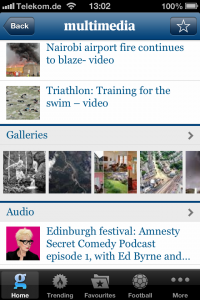 Precisely. It may be that the small text paragraph becomes the most important thing to get you into a story, and then later be presented with more material for that. The Washington Post found that with trying to put one of their big investigative stories onto a Blackberry – it took 46 screens to do it. And they said no one is going to go through 46 screens to read it so how are we going to tease them with something on the Blackberry that says: “Big issue, important issue, come back here or when you get home get your iPad out and have a look.” I mean what’s interesting about mobile devices is that most of them are used in the home. We think that everyone is out on public transport using the mobile, and that does take place, but the greatest use of mobile devices is at home. And that’s because people at work might use their PC’s or their laptops, and they might see things , and then they go home and they use a tablet or something. And the more people are using these mobile devices, the more information they are actually consuming, and the more long form information they are consuming. So, just because they first encounter it on a smart phone does not mean they only want the tweet or they only want that paragraph. It actually gets them into consuming more and more long form content. And that’s a really important thing. All of this is coming together to drive certain people to engage with material over a longer period of time and at a greater depth. Organisations like the Wall Street Journal conclude that people are spending as much time with their iPad app as they would have ever done with the newspaper. And I suspect in the next couple of years it will be much more time.
Precisely. It may be that the small text paragraph becomes the most important thing to get you into a story, and then later be presented with more material for that. The Washington Post found that with trying to put one of their big investigative stories onto a Blackberry – it took 46 screens to do it. And they said no one is going to go through 46 screens to read it so how are we going to tease them with something on the Blackberry that says: “Big issue, important issue, come back here or when you get home get your iPad out and have a look.” I mean what’s interesting about mobile devices is that most of them are used in the home. We think that everyone is out on public transport using the mobile, and that does take place, but the greatest use of mobile devices is at home. And that’s because people at work might use their PC’s or their laptops, and they might see things , and then they go home and they use a tablet or something. And the more people are using these mobile devices, the more information they are actually consuming, and the more long form information they are consuming. So, just because they first encounter it on a smart phone does not mean they only want the tweet or they only want that paragraph. It actually gets them into consuming more and more long form content. And that’s a really important thing. All of this is coming together to drive certain people to engage with material over a longer period of time and at a greater depth. Organisations like the Wall Street Journal conclude that people are spending as much time with their iPad app as they would have ever done with the newspaper. And I suspect in the next couple of years it will be much more time.
What models for financing visual storytelling projects should journalists and media organisations be looking at?
There are two things to say firstly. One is the old model is dead, which is why organisations are in trouble. The historical perspective is important. What we now understand is all good journalism was always subsidised. It did not pay for itself directly. People were not asked to pay for it directly, and it was subsidised by advertising. It’s an obvious point at one level but it’s really important to keep in mind because now what people are saying is: “why don’t people pay for journalism? Why don’t I pay for this individual article or whatever?” Well historically you have not been asked to, and historically it’s been subsidised by advertising. And that’s because newspapers were the best way for advertisers to reach a mass audience.
Now newspapers were declining, and circulation from the 1950s, because every time they encountered a new technology such as radio or TV, the circulation went down. But certainly the disruption of the Internet has really transformed advertising. The great crisis now is not so much a crisis in journalism, because in journalism as a practice there’s more great journalism from around the world but it it’s in different places. There is more great stuff being written, shot, produced than at any time. It’s just not necessarily coming out in major media organisations all being paid for in a big way.
The crisis is a crisis in advertising. And that’s what’s falling off a cliff in North America, and has been declining everywhere else and the graphs and studies show that when you get to 2000 and “kaboom!” – we’re talking about losing about 20 or US$30 billion out of the industry in the space of a few years. And that’s what’s really undercut journalism. We have to understand that journalism was always crossed subsidised. So where is it going to find its next cross-subsidy? Well, some of it will still be advertising, some of it will be direct reader or viewer contributions from readers paying for apps and so on. But what people pay for is not really the content directly, what they pay for is the user experience. And then there will also be collaborations with other organisations and so on.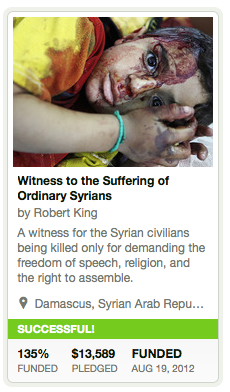
We can’t be searching for a single business model. We can’t be searching for a pot of gold. We’ve got to think about how advertising, subscription, sponsorship, transaction, and partnerships come together for organisations that want to produce good journalism.
So we can’t approach this question as: “OK I want to do a Snowfall story who is going to pay for it?” But it should be who can we partner with to make this possible? And we’re going to have to have a range of partners or collaborators to make that possible. Because it’s not going to be approached as a single commodity to buy – even by media organisations, as they are tending to produce these things in-house.
You have to approach it from the question of indirect, cross-subsidy, and you’ve got to look at from four to five different revenue streams. And then each organisation has to work out what it can do in its own context.
From your research, what’s your advice for journalists wanting to embrace visual storytelling?
You have to understand that you’re operating in a global digital space, and you need to have your own part of that digital global space and connect to networks. That’s going to involve collaborations for producing things, and partnerships for distributing things, and you need to think about where the audience is.



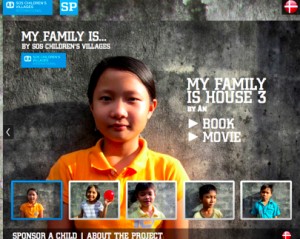

Feedback